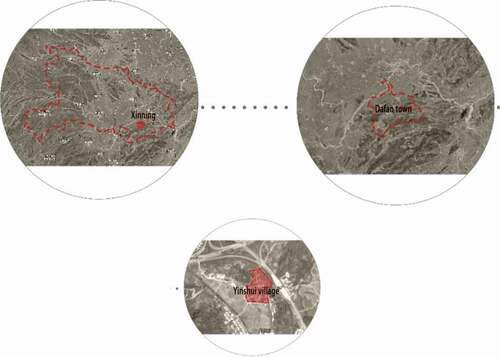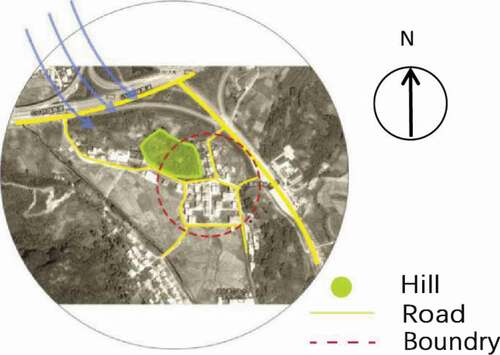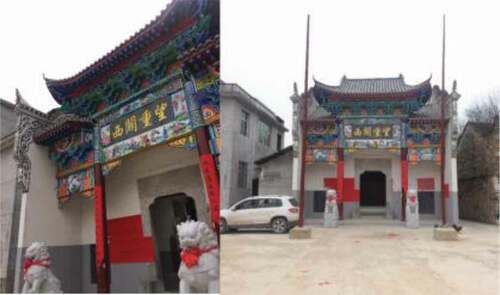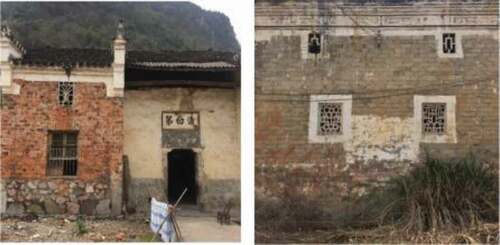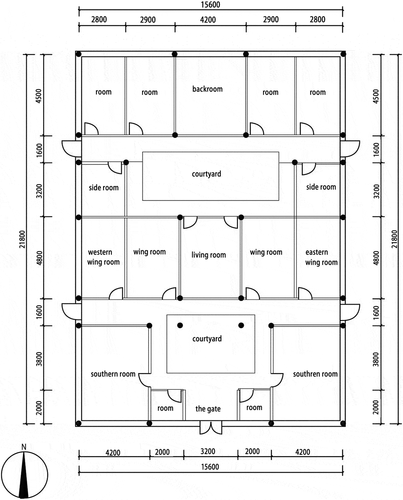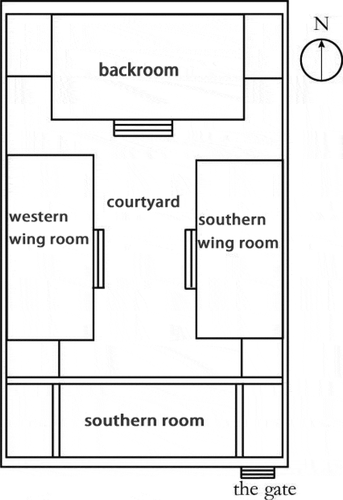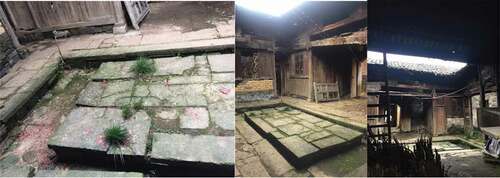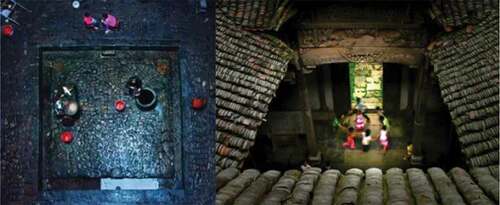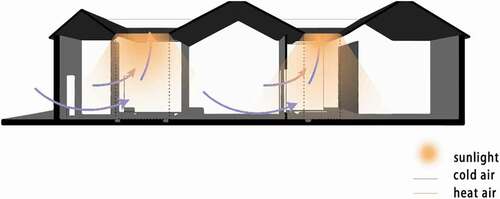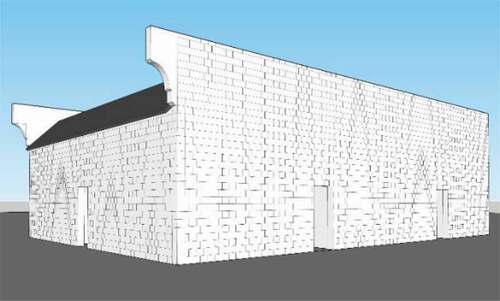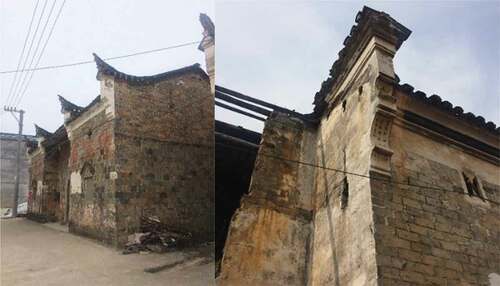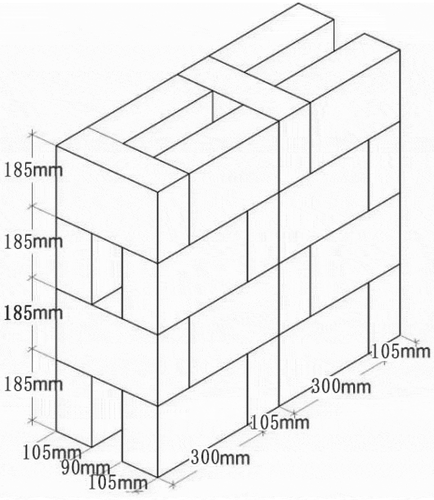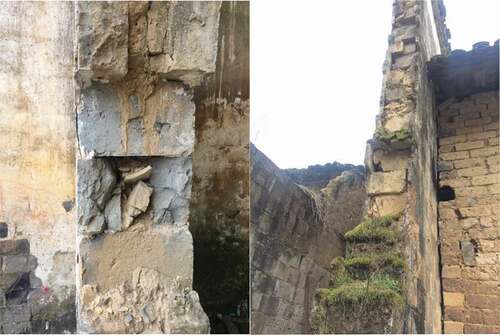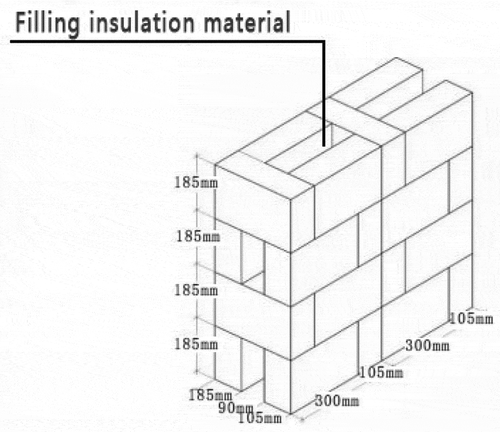 ?Mathematical formulae have been encoded as MathML and are displayed in this HTML version using MathJax in order to improve their display. Uncheck the box to turn MathJax off. This feature requires Javascript. Click on a formula to zoom.
?Mathematical formulae have been encoded as MathML and are displayed in this HTML version using MathJax in order to improve their display. Uncheck the box to turn MathJax off. This feature requires Javascript. Click on a formula to zoom.ABSTRACT
This study performed field surveys and investigated the formal and technological characteristics of traditional buildings in the Southern area of Hubei province, China, and reviewed the related historical archives and literature. This study is helpful for architects or urban administrators to understand how traditional vernacular buildings contribute to energy saving. After field surveying and mapping of these traditional buildings, this study found that the materials and the constructions of traditional buildings as well as the pattern and the layout are different from current buildings, which might lead to the high effective energy saving of traditional houses. This type of architecture can effectively improve the living environment through adjusting temperature, and improve illumination and ventilation according to the conducted testing. Also, the thermal and heat environments of traditional vernacular buildings are analyzed using BIM software. The results of the analysis demonstrate that these type of buildings can maintain great thermal and heat environment by similar building structures and materials, which also could meet the current standards in Hubei. These works demonstrate that traditional vernacular buildings could be as samples for architects when they want to make an effort on green building.
1. Introduction
The importance of building energy conservation has attracted more and more attention of the government, the state has successively promulgated various energy conservation indicators and norms for various types of buildings, including buildings in rural areas. Some norms are targeted Hubei province, like the “Design Standard for Energy Efficiency of Residential Buildings in Hot Summer and Cold Winter Zone” (JGJ134-2010), the “Design standard for energy efficiency of residential building in Hubei“ (DB42T_559-2013) and the “Regulations on energy conservation for civil buildings” were promulgated. In 2017, Hubei held a coordination meeting for the preparation of the “Technical code for energy efficiency door and window engineering”. It can be seen that Hubei attaches great importance to the energy conservation of residential areas, which brings strong and powerful policy guarantees for the energy conservation of rural residential areas.
In China, now, residential building area has reached 20 billion square meters (Sui and Wang Citation2013), which takes an enormous proportion of existing building areas. Moreover, Hubei province is a large province of population and resources in Middle China. It has a large amount of energy and resource consumption. Energy saving and emission reduction of residential buildings can effectively reduce the energy consumption of resources in Hubei province, which can help Hubei building a sustainable city and boosting the local economy.
Although ancestors have no advanced equipment to construct buildings for the reason of limitation of technology, they use their own wisdom and natural methods to improve the comfort of living space and guarantee a good hot-humid environment, reaching the balance of low thermal energy consumption. It can be seen that there are many excellent, effective and low-cost energy-saving approaches in traditional buildings, which still have a wide range of reference values under certain conditions, especially for rural areas where the economy is underdeveloped (Zhang Citation2012).
Hubei province belongs to the zone with hot summer and cold winter. Therefore, the thermal insulation is an important indicator to evaluate the comfort of residential buildings. This article is motivated by energy saving + BIM technology of traditional residential areas, which attempts to provide new energy-saving technology references for the new rural construction according to the investigation and data analysis of traditional residential areas around the town of Dafan in Tongshan County.
1.1. Theoretical background
Since the global energy crisis, human being realized environment resources should be protected and now, nearly half of the world’s carbon emissions are generated by the construction industry (Zhai and Previtali Citation2010), while energy-efficient buildings have the potential to reduce carbon emissions by 60% (Tzikopoulos, Karatza, and Paravantis Citation2005). Therefore, the research requirement on energy conservation in residential buildings has become inevitability (Singh, Mahapatra, and Atreya Citation2009).
Most academic surprisingly find out that most vernacular buildings have great efficiency of energy saving, so more and more researchers, such as Huang and Lan (Citation2010), Fabbri and Tronchin (Citation2006), Engin, Vural and Sumcrkan (Citation2007), Indraganti (Citation2010), have studied energy saving of traditional houses and set examples of different types of those typical houses in order to inspire more scholars to study the high-efficiency energy saving of vernacular houses. In addition, some Chinese scholars like Chen (Citation1980), Zhao (Citation2005), Chen and Zhang (Citation2008) did lots of site measurement and comparison of the traditional residential building form, architectural layout and building components in a Chinese village for providing many study samples.
Some scholars creatively studied energy-saving houses with advanced technology – such as passive solar energy technology used by Manoj Kumar Singh (Citation2009), specific equipment like Nissan Thermo Recorder self-meter thermometer, space temperature field distribution and digital temperature detector (PROCOS-VII) used by Zhang to test the thermal environment (Citation2006), quantitative methods like Analytic Hierarchy Process (AHP) used by Li daoyi to determine the effect weight of the thermal adaptation of human body (Citation2017). In recent decade, new tools – BIM technology was brought to public and some researchers like Wang (Citation2015), Wang (Citation2015), Wang (Citation2014), Azhar et al. (Citation2010; Citation2011), Ram, Gavali and Ralegaonkar (Citation2018) used BIM to calculate the accurate value of energy efficiency that traditional houses can offer. However, the results of these calculations are different from one to another, because the method of measurement is not the same. For example, shows that the proportion of National Building Energy consumption in National Energy consumption is diverse from different papers between 2003 and 2016.
Figure 1. The proportion of National Building Energy consumption in National Energy consumption between 2003 and 2016.
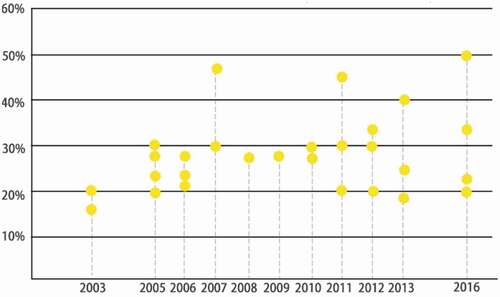
Others think region or environment condition is one of the affected factors about high efficiency of energy saving that traditional buildings have,; thus, they study houses according to the division of different regions. For example, Liu (Citation1994) put forward some practical application technology targeting at hot summer and cold winter zone which usually refer to central China. Wang (Citation2008) tried to put forward measures for building energy conservation by learning the feature of the town planning and building pattern in central China. In addition, from the perspectives of local climate and geography situation, Sun (Citation2009) tries to explain how the locations, water supply and the courtyard of traditional architectures in Hubei can make an effect on energy saving.
Although different aspects have been studied by scholars, in Hubei, there still lack research which introduces method combined with traditional and quantitative methods. Thus, in order to fill this research gap, this paper tried to employ new ways and set an example to others.
2. Research methodology
This study synthetically applied historical document research, as well as field measurement and digital analyses of traditional buildings in a selected village called Yinshui in Hubei. This study has obtained the digitally derived geometric proportion-relationship and design patterns of those typical buildings and analyzed features, materials and the structures of those typical buildings.
A Cross-reference Research of Historical Documents and Literature
Through a comprehensive investigation, this study collected related historical documents and literature about traditional vernacular buildings in the South area of Hubei. It also conducted cross-reference research on the useful information thus extracted, while verifying the results of digital analyses.
(2) Field Measurement
Digitization and analyses of related drawings:
Measuring the architectural plan of the vernacular house (), as well as the size of some special structure ( and ).
Recording the shape coefficient, building orientation, windows-wall ratio and residential building perimeter protection structure of the vernacular house.
(3) A local background survey by the interview method
Government officials and local residents were interviewed to understand the situation of typical traditional residential buildings, functions, preservation status and so on. In addition, the lifestyles and the way how locals use or live in those vernacular houses could be understood.
(4) Quantitative Analysis
The data obtained during the field measurement were calculated using BIM software, which is suitable for processing and working with collected data, its analysis and the determination of data correlation. The efficiency of the heat and thermal environment was simulated and compared with the current standard.
3. The situation of the research object
3.1. Local climate and surroundings
Tongshan town, County Dafan is located in the southeastern of Hubei Province (), sharing the same climate conditions with other counties in Hubei province which is located in the typical monsoon area. Except for alpine areas, Hubei belongs to subtropical monsoon climate, which means the seasons change distinctly in Hubei and the resource of water is rich.
This paper takes the residential buildings of Yinshui Village as the research object for the reason that it can provide valuable data for us to study with the complete present village layout, great preservation of traditional houses as well as some public buildings. Villagers placed their houses along the hillside foot which Yinshui is placed in the southeast corner of the hillside so that they have a natural barrier to resist the northwestern freezing winds of winter. Of the total area of 2400 acres, Yinshui has 1184 acres of arable land, 757 acres of paddy field and the rest field is taken by 404 families which is 1936 people.
Yinshui Village has great accessibility with the Hedian highway and the entrance and exit of Hang Rui High-speed on the west side. A tourist spot called Yinshui Hole located on the south side of the village while the east is currently not developed ().
3.2. Local building conditions
In order to cater to the modern needs like air-conditions and electrical equipment, local government takes some actions and policies for new countryside construction, so more and more traditional houses are rebuilt and transformed while those valuable traditional houses become less and less. In Yinshui, we found that villagers rebuilt the ancestral shrines () and some old buildings (). Therefore, well-preserved historic buildings are rare in Yinshui village, but there are still two relatively valuable historic traditional houses built in Ming Dynasty, one is the Longxi ancestral hall and the other is residential buildings ().
Table 1. Basic information of study objects.
Both buildings are relatively intact, except for the construction of wooden beams and tile roofs. The overall enclosure structure of the residential buildings still remains.
4. Result and discussion
4.1. The energy saving of layout
After studying the subject we selected, we found that most traditional houses have some features listed as follows, which helps reducing energy consumption.
Small-scale building size.
The floor plan of the residential buildings () shows that building modulus is small, which means that it can save building materials effectively. In order to improve the use of space and meet the needs of living, the building depth generally larger, about 3–10 m. Besides the small modulus, ancestors used partitions to make each room size small and appropriate as well so that the heat can preserve longer.
(2) Overall layout strives for southward.
The architectural plane of the traditional residential buildings () shows that the form of residential is very similar to the Beijing courtyard (). As we know, the basic form of Beijing courtyard composed of western and eastern wing rooms, southern room, backroom (also known as principal room), and a center roughly square courtyard. There is a typical rule about Beijing courtyard as well, which is the main entrance always located in the southeast corner of the house, so because of the layout of the house, people living in the house can get better sunshine in the winter. On the other hand, people in colder climates regions can get most benefits for the layout because the west side wall called the Shanqiang in Chian, can reduce the excessive heat brought by the sun with strong solar radiation and can avoid overheat, which helps to maintain a good indoor thermal condition.
4.2. Energy saving in building construction
4.2.1. The courtyard
Traditional houses in southeast Hubei always have a courtyard that is used to close to nature and a public space for families to strengthen their relationship. The courtyard of ancient houses in Hubei is usually narrower than the other regions, with a ratio of about 1:3 to the area of houses, compared with about 1:2 in Beijing. There are three reasons for the narrowness of the courtyard in Hubei. One is that the latitude of Hubei is lower so the requirement of sunshine is lower than that of the north, and the distance between buildings is relatively small, because of that there is no necessity of a large courtyard. Secondly, it is difficult to meet the demands of large-scale courtyard because of the complex terrain and limited land use in Hubei. Thirdly, the narrow and small courtyard can also form a large wind pressure causing a remarkable effect of ventilation and forming a good ventilation circulation system. In Chinese culture, the layout of courtyard form a good Feng Shui, bringing good luck to people and people also called the courtyard as “the water return to the hall” () which means that money (Chinese regard water as money) falls from the sky to their house.
Besides, the courtyard space creates a negative space in the house bringing positive living environment-like residents would like to play or work in the courtyard (). It is different from the western patio, the courtyard in China is an external continuation of the interior space rather than just a divided individual space. To some extent, the courtyard makes the buildings in ancient China very spectacular.
After studying and assess the courtyard, we found the courtyard plays an important role in building emission reduction and energy saving and its main functions are as follows:
Ventilation
Natural ventilation can be formed in the courtyard through the generation of wind pressure (Sun, Citation2009), because doors and windows in the buildings are opened specially to strengthen the effect of ventilation. People put doors and windows in the corresponding position of the upwind and leeward in the houses so that different wind pressure is formed between the indoor and outdoor environments. The air flows from the high-pressure side to the low-pressure side under the action of this pressure difference, which refreshes the air in the house. For the airflow movement caused by the wind pressure, the opening of the barotropic surface acts as an inlet, and the opening of the negative surface acts as an exhaust. Therefore, the air flows through the barotropic side and out from the negative side, and without any barriers (like furniture, walls, etc.) inside, the traversing ventilation is formed.
According to Bernoulli’s fluid principle, which is the pressure of flowing air decreases with the increased velocity, a low-pressure region is formed. Thus, the transverse ventilation passage can be set aside in the building so when the wind blows through the passage, the negative pressure zone which will lead to the flow of the surrounding air will be formed. This ventilation method can achieve a better effect in the deep building space, which is exactly the case with the traditional residential buildings in Hubei province ().
(2) Daylight
The courtyard cannot only organize natural ventilation but also carry out natural lighting. Because the layout of courtyard houses is narrow and the interior of most houses is enclosed by the enclosed surface lack of sunlight, the light scattered from the narrow of the courtyard is the strongest and most desirable in the interior. Moreover, the light entering from the courtyard is mostly secondary refraction light which is seldom natural glare and softer than outside and worth studying. It can be seen from the clairvoyant section of traditional houses that there is a courtyard between houses which bring sofer light and certain changes to the interior of buildings ().
In order to verify the concrete effect of the traditional residential courtyard on ventilation and daylight, we tested light intake, ventilation, and the indoor temperature on a traditional house. We targeted the traditional residence mentioned above in Yinshui village and selected 16 test points – two outdoor points (One is 1 m far from the door, the other is far away from the house) and 14 indoor test points (No. 10, 11, 12 are the points near the courtyard) (). We used the outdoor points as contrast subjects and then record the temperature, humidity, illuminance and wind speed of the different sites in or outside the house. According to the recorder, the temperature of outdoor points is 23.2°C and 23.5°C respectively, while the average temperature near the patio is 18.725 and illuminance near the courtyard is stronger than the points elsewhere in the house, which means that the courtyard has the ability to balance the heat environment inside the home and can improve daylighting.
(3) Drainage
Table 2. Test data of temperature, illumination, ventilation in the traditional residential.
Drainage is an important function of the courtyard in daily life. There is a component of the courtyard called ring trough, which is a sink square pool sinking from the indoor floor. The direct function of this component is to collect rainwater and avoid the inside floor is deluged with rain ().
Most ancient buildings have excellent drainage facilities. The most common form of the drainage is to build ditches in the four corners of the patio. Besides, the roofs of the four surrounding houses are inclined, they lead rainwater to flow from all directions into the patio. With the gravity, rainwater will flow into the ditch under the courtyard with slightly incline and then drains out the house. In order to remove rubbish (like leaves, dust, etc.) which might block the drainage, black stone plates are often cut into round holes in various forms or hollowed-out stone covers on the outfall to stop the rubbish. We found there are some corresponding holes in the external wall of the building and we assume those holes are to help to drain, and we also confirmed from the villagers that the opening of the external wall is indeed for drainage in the after interviewing the locals.
Despite the good system of drainage, the construction of the courtyard is exquisite. It has different sizes, depths, shapes, materials, and sculptures according to the house. For example, we found there is a courtyard built with stone and the stones carved with different patterns.
4.2.2. The wall
Resist foreign enemies.
The exterior walls of traditional houses are very sealed, except for the gate and side door, almost no windows are opened. This is related to the super-defensive consciousness of the ancestors, so in order to prevent the invasion of outsiders, ancestors minimize the opening of windows ().
(2) Fire prevention.
The layout of Hubei traditional residential villages is very dense and most of the houses are a wood structure, which always has fire hazards, so the fire prevention measures are particularly important. The exterior of the building is protected by brick walls and the roof is protected by horse headwalls (also known as firewalls) which are high above the roof and have great effective containment of fire spread ( and ). Moreover, large tanks of water can be found in the courtyard, and some people build a large pool in the courtyard for firefighting (Tao Citation2013).
(3) Heat preservation.
The solid wall (average thickness is 300 mm) built by soil and brick which has the advantages of good thermal insulation and heat storage ability, and can adapt to the cold winter climate. Therefore, it can resist the effect of the temperature difference in the morning and evening on the indoor thermal environment. Although the sealed exterior wall has some disadvantages, the heat transfer and heat loss in and out of the room are reduced because of the sealed wall and the effect of heat preservation is achieved.
The walls of the traditional dwelling houses in Yinshui village are mostly rowlock wall, which is constructed by the rowlock masonry and is a kind of traditional wall could be dated back to the Ming Dynasty in China. The hollow is formed in the wall by building or flattening the brick vertically and horizontally and then the hollow is filled with lime, sand and broken brick. The rowlock wall has the function of saving material, sound insulation and heat insulation, so it has been widely used in the construction of folk houses, temples, and the building near Yangtze River valley and southwest China (Guo Citation2010).
In the town of Dafan, the sizes of traditional blue brick can be divided into five types to cater to different constructing characteristics. In , we can see that the thickest brick is 105 mm and the thinnest is only 30 mm. The most common masonry in Yinshui Village is the empty bucket wall (). In addition, comparing to the modern reinforced concrete beam-column, the stability of the brick wall is poorer, so the wall is easily washed away by rain or strong wind. To solve the problem of instability, people usually put a whole piece of stone at the corner of the traditional house to enhance its stability, which is worth studying. In , we can see that the height of stone can up to 1 m and the width is normally 300 mm.
4.3. Calculation of building energy saving based on BIM technology
This paper hopes to provide some valuable reference data by exploring the current comfort of traditional houses. Therefore, in addition to the plane-layout summarized above, the energy-saving effect of courtyard and the thermal performance of wall were evaluated by BIM.
According to the local standard of Hubei Province, “Energy Saving Design Standard of low Energy consumption Residential Building” (DB42T-559-201), six aspects need to be measured: indoor thermal environment, planning layout and building, ventilation, heating, thermal performance of enclosure structure, water supply and drainage as well as electrical energy saving. This paper focuses on the calculation of the building shape coefficient which is the aspect of planning layout and building and the thermal property of the enclosure structure.
4.3.1. Comparison of standards of the building shape coefficient
Referring to the local standard of Hubei Province (), we evaluated the building orientation and the building shape coefficient by geometric parameters. The geometric parameters of traditional residential construction are summarized in .
Table 3. Limit value of building shape coefficient.
Table 4. An outline of the geometric parameters.
Yinshui Village is located in the climate area A, and its building shape coefficient is between 0.45 and 0.55. The residential building is less than three floors and its building shape coefficient is 0.49, which meets the local standard of Hubei Province.
4.3.2. Calculation of thermal performance of building enclosure
According to the analysis method and principle of “Analysis on thermal performance of Wannan residential wall” (Di and Wang Citation2014), the larger thermal resistance and the smaller heat transfer coefficient of the wall, the better thermal stability and the better thermal insulation performance of the wall (Chen and Tang Citation2009). The thermal resistance R and heat transfer coefficient K of the wall can be calculated and analyze their thermal properties. When the envelope structure is composed of several different layers of materials parallel to the direction of heat flow, the formula of thermal resistance is as follows:
where
Rn is the thermal resistance of each layer material, m2·K/W;
dn is the thickness of each layer material, m;
λn is the thermal conductivity of each layer material W (m K)- 1;
The internal surface heat transfer resistance of Ri is 0.11, m2·K/W;
Re is the outer surface heat transfer resistance is 0.05, m2·K/W.
Calculation formula of heat transfer coefficient:
The authors collected the basic and needed information () to evaluate the thermal and heat environment.
Table 5. Materials used in the house.
The main materials of the wall are Fair-Faced brick (clay brick) which normally used in traditional buildings. The bricks are made by molding, drying, roasting and cellar kiln technology and are easily affected by different metal composition in soil, so the bricks have the advantages of strong practicability, high strength, water resistance and frost resistance. In this paper, the average thermal conductivity of the wall is 0.470 (Xu, Huang and Wu Citation2011).
According to formula (1) (2) (3) above, the thermal resistance can be calculated as:
Heat transfer coefficient is:
As listed in the stipulation of Hubei Province local standard (), the heat transfer coefficient K of the outer wall is less than 0.60, that is to say, the energy-saving of traditional residential building do not meet the modern standard and its insulation effect is also not satisfied.
Table 6. Thermal performance limit of building envelope in Hubei province.
Thermal bridge had been neglected because there is no metal material in the traditional residence and the data of thermal conductivity and heat storage coefficient of the material are not uniform. Therefore, the heat transfer coefficient of the outer wall can be calculated roughly.
The standard heat transfer coefficient in Hubei area needs to be less than 0.60 but the results are 1.570 (not meet the standard value), probably because the walls are aging and old. However, the century-old architecture can still play a certain role today, which is acting as a study object as well as a tourist attraction.
In short, the building shape coefficient in Yinshui Village meets the modern standard, while the thermal properties of the enclosure structures do not meet the requirements ().
Table 7. Conclusion.
5. Energy-saving renovation strategy of the outer envelope of traditional residential buildings
5.1. Energy-saving renovation of roof
The traditional houses in the south of Hubei Province are all pitched roofs. The main way of reconstruction is to add roof insulation materials. For example, laying a layer of insulation board under the rafter is equivalent to increasing the thickness of the insulation board and reducing the energy consumption due to the loose connection between the insulation board and rafter.
5.2. Energy-saving transformation of exterior wall
5.2.1. The empty bucket wall reconstruction
In the traditional villages, many traditional houses adopt the method of empty bucket wall. On the basis of maintaining the exterior wall style of the building, the original method of filling yellow mud or not using filler is improved. The empty bucket wall is filled with suitable thermal insulation materials to improve the overall thermal insulation performance of the exterior wall (see ).
5.2.2. Use of thermal insulation materials
Traditional houses are composed of wooden columns and walls. Some of the wooden columns are exposed outside the walls. In order to reduce the loss of energy consumption due to the loose connection between the insulation board and the wood column, the insulation layer is set between the wooden columns. And a layer of insulation material is added on it.
In order to improve the indoor temperature in winter, reduce the indoor temperature in summer, the thermal insulation mortar can be used on the exterior wall. Therefore, it can make the annual temperature change more gentle.
The use of thermal insulation mortar on the exterior wall of the building can improve the indoor temperature in winter and reduce the indoor temperature in summer, making the annual temperature change more gentle, and optimizing the comfort experience in life.
5.3. Energy-saving windows
The window is the opening part of the building envelope, where there is more energy loss. Energy-saving windows can be used to reduce energy consumption. For example, the heat transfer coefficient of the hollow plastic steel window and single frame double glass wood window is low () (Liu Citation2017). In consideration of the coordination of traditional architectural styles, single frame wooden windows can be used to replace the original windows in the reconstruction of ancient houses.
Table 8. Heat transfer coefficient of six sorts of windows.
6. Conclusion
It can be concluded that the implemented sustainable design strategies and methods that are in correlation with special components and materials used in the example of the traditional houses are being recognized. The applied sustainable design methods from the example of the house are an integral part of the strategies that include both energy conservation and material conservation during the pre-building, building and post-building phases. Comfort and rationality, as important virtues of the masterbuilder, contributed to a large extent to finding smart solutions with regard to balance the heat and thermal environment in typical hot summer and cold winter zone. In the process of design, due to the organic perception of architecture, the basic, conceptual, foundations of modern sustainable architectural design can be traced. The practice of the insulation materials, structures of the wall in Yinshui village, as well as the building layout can keep warm, conducive to ventilation and minimized energy waste. Another important sustainable strategy seen in this example is the practices of courtyard which can improve the lighting condition and balance the extreme weather in Hubei (the result can be seen in the test in chapter 4.2.1) that can reduce carbon emission.
Better understanding and respect for the sustainable qualities of traditional houses can contribute to a more thoughtful implementation and an enhancement of the quality of conservation work. On the other hand, relying on the local building principles that are characterized as sustainable and their use as guidelines for the design of contemporary houses would contribute to the preservation of their uniqueness, authenticity and regional texture and would fit into the proportions and scale of the town. In other words, adapting the regional design and building techniques, using locally available materials according to modern standards and modern technology, can result in creating outstanding regional examples of sustainable architecture.
Disclosure statement
No potential conflict of interest was reported by the authors.
Additional information
Funding
Notes on contributors
Hong Xu
Hong Xu received the M.Sc. and Ph.D. degrees from Wuhan University, in 2004 and 2013, respectively, where she is currently a Associate Professor with the School of Urban Construction, Wuhan University of Science and Technology. Her research interests include architectural history and theory, architectural design and its theory, green building technology, digital city and architecture.
Zhengbing Liu
Zhengbing Liu received her Bachelor Degree at Wuhan university of science and technology and now she is an assistant architect designer in Hualan Design & consulting Group. She is mainly engaged in architectural scheme design, construction drawing design and project schedule management.
Changyou Wu
Changyou Wu is an Associate Professor in the School of Urban Construction, Wuhan University of Science and Technology. His research interests include architectural history and theory, architectural design and its theory, urban planning and design, beautiful countryside construction.
Junyan Zheng
Junyan Zheng received her Bachelor Degree at Wuhan university of science and technology and now she is master degree student at the School of Architecture of The Chinese University of Hong Kong (CUHK). She is interested in the topics of urban renewal and sustainable community.
Liang Zuo
Liang Zuo is a master degree student in the Civil and Construction Engineering at Wuhan University of Science and Technology. His research interests include building information modeling, green building, structural mechanics.
References
- Azhar, S., J. W. Brown, and A. Sattineni. 2010. “A Case Study of Building Performance Analyses Using Building Information Modeling.” International Symposium on Automation and Robotics in Construction 27: 213–222.
- Azhar, S., W. Carlton, D. Olsen, and I. Ahmad. 2011. “Building Information Modeling for Sustainable Design and LEED (R) Rating Analysis.” Automation in Construction 20: 217–224. doi:https://doi.org/10.1016/j.autcon.2010.09.019.
- Chen, S. 1980. “Foreign Energy-saving Building Picking Up.” Today Science & Technology, no. 12: 19.
- Chen, Z., and M. Tang. 2009. Building Physics (Graphic Edition). Beijing: China Architecture & Building Press.
- Chen, Z., and S. Zhang. 2008. “The Passive Techniques about Energy Efficiency in Chinese Traditional Dwellings.” Huazhong Architecture 26 (12): 204–209.
- Di, P., and Z. Wang. 2014. “Analysis on Thermal Performance of Wannan Residential Wall.” Journal of XI’AN University of Science and Technology 34 (3): 279–283.
- Engin, N., N. Vural, S. Vural, and M. R. Sumcrkan. 2007. “Climatic Effect in the Formation of Vernacular Houses in the Eastern Black Sea Region.” Building and Environment 42: 960–969. doi:https://doi.org/10.1016/j.buildenv.2005.10.037.
- Fabbri, K., and L. Tronchin. 2006. “The Relationship between Climate and Energy in Vernacular Architecture in Central Italy.” Proceeding of the 23rd Conference on Passive and Low Energy Architecture. Geneva, Switzerland. 6-8 September, 2006.
- Guo, C. 2010. “Classification and Performance of Building Energy-saving Materials.” Shanxi Architecture 10: 159–160.
- Huang, L., and B. Lan. 2010. “From Regionalism to Sustainability: Development of Foreign Study on Climatic Responsiveness of Vernacular Building.” Architectural Journal 11: 103–107.
- Indraganti, M. 2010. “Understanding the Climate Sensitive Architecture of Marikal, A Village in Telangana Region in Andhra Pradesh, India.” Building and Environment 10: 10–13.
- Li, D. 2017. Human Body Heat Adaptation and the Design of Architecture Saving Energy and Optimization in the Rural Area of Turpan. Henan Polytechnic University, Master dissertation.
- Liu, H. 2017. Research on the Application of the New Technology of the Comprehensive Transformation of the Indoor Environment Quality in Traditional Village Houses. Chongqing: Chongqing University.
- Liu, K. 1994. “Application Technology of Building Energy Saving in Central China.” Housing Science, no. 9: 10–13.
- Ram, S., H. R. Gavali, and R. V. Ralegaonkar. 2018. “Assessment Of Energy Efficiency in Buildings Using Synergistic Walling Material.” Proceeding of The Institution of Civil Engineers-Energy 171: 182–189. doi: https://doi.org/10.1680/jener.17.00029.
- Singh, M. K., S. Mahapatra, and S. K. Atreya. 2009. “Bioclimatism and Vernacular Architecture of North-East India.” Building and Environment 44: 878–888. doi:https://doi.org/10.1016/j.buildenv.2008.06.008.
- Sui, J., and S. Wang. 2013. Research on New Type Energy-saving Mode of Traditional Houses in Shandong, 4–6. Beijing: China Atomic Energy Publishing House.
- Sun, X. 2009. A Study on the Energy Conservation of Thought and Technology for Traditional Buildings in Hubei. Wuhan University of Technology, Master dissertation.
- Tzikopoulos, A. F., M. C. Karatza, and J. A. Paravantis. 2005. “Modeling Energy Efficiency of Bioclimate Buildings.” Energy and Buildings 37: 529–544. doi:https://doi.org/10.1016/j.enbuild.2004.09.002.
- Wang, J., and Y. Shen. 2014. “Energy-efficient Visual Calculation on the Concept of Open Selective BIM.” Building Energy Efficiency, no. 5: 78–84.
- Wang, L. 2008. “Preliminary Study on Energy Saving Planning of Urban in Central China.” Science & Technology Information, no. 2: 89.
- Wang, Y. 2015. The Research on Housing Prototype of Low-energy and New Countryside Basing on BIM in Hubei Province - Take Taiping Village, Huai’an County and Luanxie Village, Shahe City for Example. Hebei University of Technology, Master dissertation.
- Wang, Z. 2015. Research on the Sustainable Recycling of Traditional Dwellings in the South of Hubei Based on BIM - A Case Study of Yingtan Village in Xingtai County. Hebei University of Technology, Master dissertation.
- Xu, J., X. Huang, and Z. Wu. 2011. “Technical Characteristics of Passive Energy-saving Building Envelope.” Journal of Nanjing University of Technology (Natural Science Edition) 5: 60–63.
- Zhai, Z., and J. M. Previtali. 2010. “Ancient Vernacular Architecture: Characteristics Categorization and Energy Performance Evaluation.” Energy and Buildings 42: 357–365. doi:https://doi.org/10.1016/j.enbuild.2009.10.002.
- Zhang, J. 2006. A Study on Thermal Processes of Traditional Dwellings. Xi`an University of Architecture and Technology, Master dissertation.
- Zhang, Q. 2012. Relevance Study on Settlement Space Characters and Climate Adaption - for Example in Southeast Hubei Region. Wuhan: Huazhong University of Science and Technology.
- Zhang, T. 2013. Study on Climate Adaptability of Typical Traditional Dwellings Envelope. Xi`an University of Architecture and Technology, Master dissertation.
- Zhao, Q. 2005. Research on the Ecological Experiences and Pattern Language of Traditional Residential Buildings. Xi`an University of Architecture and Technology, Master dissertation.

